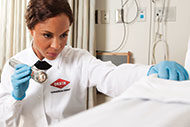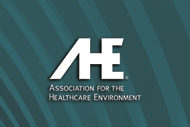Systemwide waste stream management is a huge undertaking, particularly for hospitals with multiple off-site locations. Regulatory agencies such as the Department of Transportation (DOT), the Environmental Protection Agency (EPA), the Occupational Safety and Health Administration (OSHA) and the Joint Commission evaluate every location using meticulous criteria, often specified to facility size or type. Mosaic Life Care, Mercy Medical Center Des Moines and Brookdale Hospital, each faced unscheduled site visits from regulatory agencies, but because of their proactive planning, the hospitals were able to stay steps ahead.
Case 1: Mosaic Life Care, St. Joseph, Mo.
Managing risk for Mosaic Life Care means creating, managing and aiding in the adoption of processes surrounding patient care and operations at 50 medical practices across Missouri.
Training is key to successful risk management. John Glenn of Mosaic Life Care believed training had to be comprehensive and centrally managed. He also knew he would need support and counsel to bring his vision for a fully compliant and safe Mosaic Life Care to fruition.
The problem. After highlighting this to leadership, Glenn made the case for a full-time compliance role focused on waste stream management. With 12 waste streams at 50 locations, Glenn sought external advice. He also needed the right tools.
“We are not the experts on the subject of waste stream management. Using a standardization and documentation tool made a lot of sense to us,” said Glenn.
The solution. The Mosaic Life Care team looked for a simple tool to standardize and document required DOT, OSHA and EPA training and compliance across all of their facilities that was comprehensive, easy to use, allowed unlimited users, and offered a flat fee and 24/7 accessibility. Glenn found that SteriVantage fulfilled those needs.
The system is designed to help hospital teams meet regulatory requirements, standardize training and provide documentation. With more health systems’ acquiring off-site locations, Glenn advised leaders to secure services that keep training data up-to-date in real time.
“The hospital carries full responsibility for physicians and clinics affiliated with the Mosaic Life Care system. By using [this] service, employee training and documentation become a lot more manageable,” said Glenn.
The result. Risk mitigation is now pervasive throughout the hospital’s operations, and Mosaic Life Care continues to take proactive approaches to safety. For example, the process for signing a manifest for handling hazardous waste and biohazardous packaging has improved.
“Recognizing the level of training that was needed, we swiftly developed a plan to train caregivers at more than 50 clinics.,” Glenn notes. “Proper documentation and protocols for handling biohazardous waste plays an important role in reducing risk.”
And the regulatory inspections speak for themselves.
One year, 60 percent of Mosaic Life Care’s sites were inspected by the Joint Commission. Also, for the first time in 25 years, the EPA visited the system and found it to be in compliance.
“Our clinics change locations, expand and consolidate,” Glenn says. “With a risk minimization process in place, our organization demonstrates that it takes compliance seriously. It’s quite an undertaking and worth it.”
Glenn cautions health care leaders that avoiding proactive compliance management is costly and a missed opportunity. Hiring a waste environmental specialist meets the system’s long-term objectives. With initial successes, Mosaic Life Care plans to tackle more on its own soon.
“We knew it would be challenging, but we found the right help with one solution. We are proud of our improved safety,” Glenn says.
Case 2: Mercy Medical Center Des Moines, Iowa
Gregg Daniels, director of facility services for Mercy Medical Center, had a challenge. His teams needed to understand the complexities of handling hazardous waste, regulated medical waste, sharps and pharmaceutical waste. And he needed to know how to track and document employee training for handling this waste at the growing system’s hospitals and off-site locations.
The problem. As health systems grow, it is difficult to track employees’ training in addition to monitoring the changing local, state and federal regulatory requirements.
“We wanted this burden lifted for our teams,” Daniels says. “Regular trash is not a big deal to manage, but regulated medical waste is highly nuanced and potentially dangerous. Our teams needed training on how to handle and dispose of it. Working with a customized management tool helped us to learn and adopt proper protocols. Posters and other communication pieces reinforced our ‘know-where-to-throw’ practices.”
The solution. After conducting research and implementing a documentation system across 50 sites, Daniels identified a tool that could help train his teams. Soon he identified how working with a waste stream management partner could apply to other Catholic Health Initiatives sites. SteriVantage now helps teams at sites like Mercy to meet systemwide compliance objectives to standardize employee training. The training helps systems to prepare for EPA, OSHA and the DOT requirements.
For example, with the DOT, anyone who prepares the regulated medical waste for final shipment and signs the shipping papers or the hazardous waste manifest must take training within the first 90 days of employment or after a job change and every three years from the date of that training.
SteriVantage tracks this information and highlights compliance-related activities. The intent is that by standardizing training and documentation, hospitals remain compliant and operate safely.
The result. Mercy teams are well prepared — which came to light during a regulatory agency visit. Teams are versed in facts such as a DOT requirments for red bags to be tied for disposal and packaged inside a sealed plastic container before shipping to avoid leakage and possible contamination.
Daniels shares that pharmaceutical waste compliance practices benefit from proper waste stream management. Team education about where this special type of waste goes was particularly important for many reasons. “Some pharmaceutical waste is hazardous, which prompted us to wonder if it is exempt or listed? More complex questions must be answered every time we dispose of an unused or expired medication. Is it toxic, corrosive, ignitable or reactable? It is not simple to understand or to manage. The SteriVantage tool helps me to know who is trained or not.”
Mercy tackled sharps management using reusable containers that are proactively exchanged to minimize infection risks and increase safety. “If someone gets stuck, it is a real problem. This person’s blood needs to be monitored until confirmed clear. Medications can be given as a preventive measure,” Daniels notes.
Preparation pays off. “When the Joint Commission visited, the inspectors seemed pleased to learn that Mercy had a formal program for training employees and documenting it,” Daniels says. “Having a partner that manages the training makes it easier on our staff. It is one way we continue to make the workplace safe for our teams and patients.”
Before this accountability system was developed, waste management was split across several functions: environmental services, sterile processes, nursing and safety. Instead of five departments showing up for one meeting, the medical center’s waste stream management is now handled by one environmental services team member.
“People don’t initially grasp how hard it is to understand and to stay on top of these regulations,” Daniels says. “Our team is happy to have one partner who keeps us compliant in an ever-changing environment. We are ahead of the game by a few years.”
Case 3: Brookdale Hospital, Brooklyn, N.Y.
Brookdale’s new standardized training enhances workplace safety, team education and pharmaceutical waste stream management. Leaders from the hospital recognized the need for a more strategic approach to compliance, including leveraging a third-party partner. They also knew it needed an internal champion to lead the vetting process and a multidisciplinary committee that would help to identify the best partner to assist in managing compliance training, particularly as it related to pharmaceutical waste.
Brookdale chose Stericycle because of its ability to build strong hospital team relationships and communicate with each department: environmental services, pharmacy, nursing, education and more. It also would tailor procedures based on Brookdale’s unique operations and departmental feedback.
“The company audited current hospital waste stream activity, which provided learning opportunities for our teams as we got started,” says Saumya Mathew, pharmacy manager. “There was great communication and teamwork,”
“Stericycle made recommendations for our hospital size and developed the materials to kick-start the training programs, including educational posters and the placement of color-coded bins for pharmaceutical waste,” Mathew notes.
Brookdale leaders also wanted a continual approach to compliance training with annual refreshers as well as train-the-trainer programs after initial sessions. Brookdale' s off-site locations now use SteriVantage, so that online training is easily accessible by staff at any time.
Compliance for in-patient training and new employee training was part of reviewing the hospital’s initial policy and suggesting how to improve it. Defining the different types of waste and whether they are hazardous or not became part of an overall policy of waste stream safety that was built into environmental services policies.
The problem. With multiple sites, including the main hospital, outpatient ambulatory clinics, two nursing homes, faculty practices, a retail pharmacy and an urgent care center, Brookdale knew that without compliance management, it was at risk to regulatory agency requirements. Now the standardization and documentation of training that started at the hospital is moving to at least 20 additional sites.
“We started with a lot of unknowns. Now we can pull reports for each site and we have a site-specific checklist that specifies waste stream types and whether it should be placed into an over-classified bin, for example,” Mathew says.
The solution. The new training helped Brookdale staff to learn about different waste types and proper disposal protocols. The training tool also helps teams to understand current regulations and requirements. Brookdale continues to expand its training and the data to support real-time regulatory updates.
“The hospital carries full responsibility for the staff, physicians and clinics that are affiliated with it,” Mathew says. “By using a service like SteriVantage for our off-sites, employee training and documentation is turnkey.”
The result. The hospital views third-party compliance training as a best practice for risk mitigation. The additional counsel helped Mathew's teams to shape policies and procedures. Now the network is better prepared, and her team continues to tap Stericycle’s knowledge.
The hospital continues to experience positives outcomes such as understanding that one of the common drugs it comes across was actually considered hazardous and therefore a “P-listed” waste, requiring special handling and disposal. Hazardous drugs also now go into a dedicated container and not the garbage, so that staff and patients reduce unnecessary exposure. Staff now understand the different types of drugs after a hazardous drug list was built for each floor.
“Adding a retail pharmacy in Brookdale’s family care clinic and an urgent care center are signs of our continued expansion, Mathew notes. “New OB-GYN oncology services mean that new drugs are used, but now we are fully prepared.”
Gerry van Domelen, Senior Manager of Online Compliance Solutions for Stericycle.





